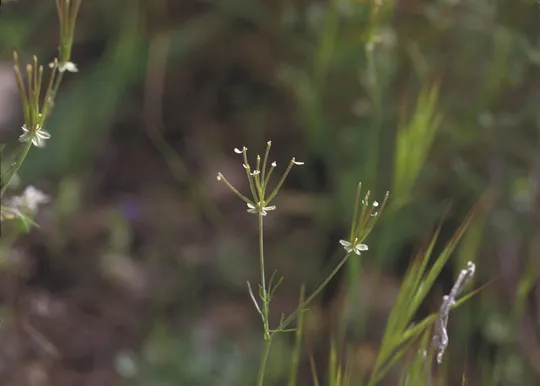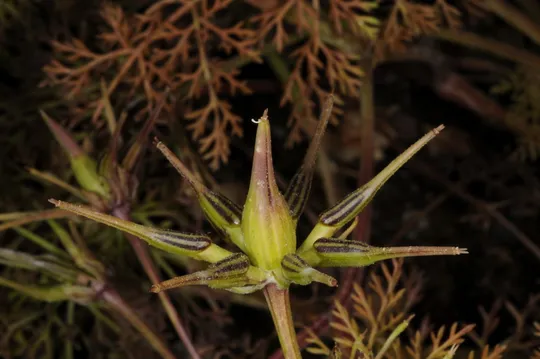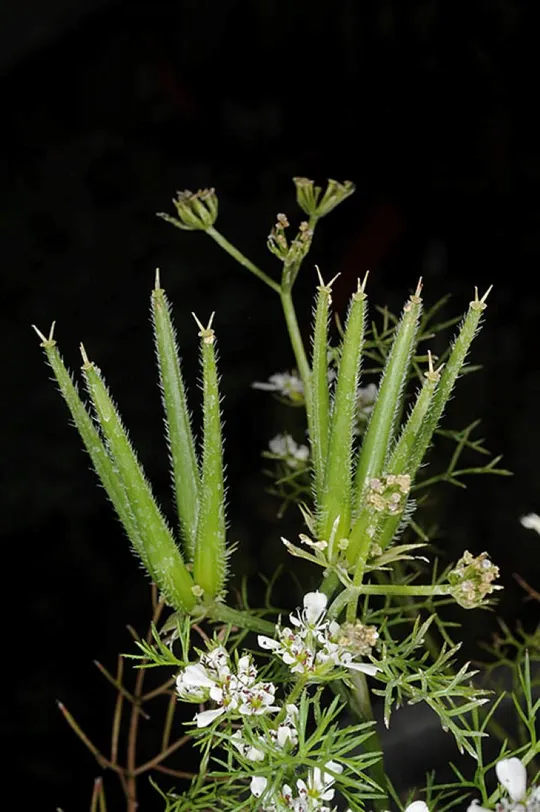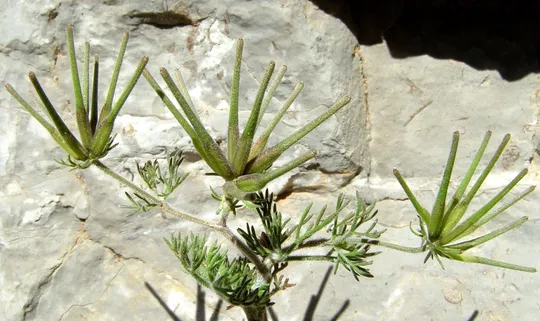Southern Shepherd's Needle
Scandix australis

Avinoam Danin first discovered Scandix australis
in Israel in 1977 in the Judean Mountains, in the Jerusalem Forest – on the
western slope of Mount Herzl. Since then two additional populations have been found
in the Judean Mountains, in southern Jerusalem – south Talpiot and west of
Ramat Rahel. There is concern that accelerated development in the area will lead to its
disappearance from southern Jerusalem.
Mediterranean scrublands and shrubland. Scandix australis
grows mainly in the Sarcopoterium spinosum and Calicotome villosa
plant association.
All the Scandix
species in Israel and in the Mediterranean Basin are relatively similar annual
species, but they are reasonably easy to identify. S. australis is a delicate plant with long
umbellule pedicels (3-4 cm). In Israel, it grows together with two extremely
common Scandix species: S.pectin-veneris that has shorter
and thicker umbel rays and grows in stony-rocky habitats; S.verna (formerly S.iberica) has larger
flowers, broader inflorescences and at least some of its outer petals are
divided into two deep lobes. The latter species is characteristic of herbaceous
vegetation landscapes.
A rare species that
was collected only twice in the Kishon Stream is S. grandiflora, which was first
identified in the Flora Palaestina as S. falcata (Zohary, 1972).
A. Danin subsequently identified it as S. grandiflora (Greuter and Raus,
1989). In the Flora of Turkey, it is described as the grandiflora
subspecies of S. australis (Hedge and
Lamond, 1972) that is distinguished by its large outer petals, 5-7 mm in
length. As stated, in Israel S. australis was collected only twice and has thus
been considered as a random plant that did not establish viable populations and
therefore was not included in the calculation of the red number of S. australis or as an
additional red plant.
Scandix australis is a very rare
plant in Israel and its distribution may have been reduced to only one site if
the Jerusalem populations were damaged following extensive urban development.
The remaining sites are not located in a nature reserve. It is not a globally endangered
plant and does not appear in red species lists.
The Jerusalem
area should be surveyed thoroughly and attempts made to identify Scandix australis populations and to
define specific sites for protection.
Scandix australis was described
from southern France. It grows from Central Europe to the Mediterranean Basin
and the Crimean Peninsula in the east (Hedge and Lamond, 1972).
Scandix
australis is a small extremely rare annual species that
grows on a small number of sites that are not protected. It is a peripheral
species and Israel is at the southeastern limits of its global
distribution.
כהן, ע. ושמידע, א. 1998. מסרק דרומי רתם 28: 73-78.
Hegde, I.C. and Lamond, J.M. 1972. Scandix in Flora of Turkey (ed. Ds, P.H. vol. 4. pp. 329-330.
Greuter, W and Th. Raus, 1989. Med-Checklist Notulae, 15. Willdenowia 19. pp. 48.
Current Occupancy Map
| 1000 squre meter pixel | 5000 squre meter pixel | 10000 squre meter pixel | |
|---|---|---|---|
| number of observations | 0 | 0 | 0 |
| in total pixels | 0 | 0 | 0 |
| Family | Apiaceae |
| Classification | On the endangered species list |
| Ecosystem | Mediterranean |
| Chorotype | Mediterranean – Euro - Siberian |
| Conservation Site | Jerusalem Forest |
| Rarity |
1
5
6
|
|---|---|
| Vulnerability |
0
3
4
|
| Attractiveness |
0
0
4
|
| Endemism |
0
0
4
|
| Red number |
1
4.7
10
|
| Peripherality | N |
| IUCN category | DD EW EX LC CR EN VU NT |
| Threat Definition according to the red book | Endangered |
 Based on:
Based on:






